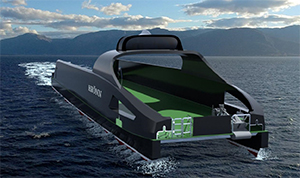Automated Ships Ltd. and Kongsberg Maritime are advancing the timeline for autonomous shipping, announcing plans to build the first unmanned and fully automated offshore supply vessel (OSV) and have it on the water within two years.
The initiative comes despite the continuing lull in offshore oil and gas drilling, which has stifled demand for service vessels worldwide. The project’s proponents don’t see that as a deterrent, however, and they planned to have a build contract in place with Norway’s Fjellstrand AS shipyard in January.
“Yes, there is a downturn, but the market is already starting to turn up and we want to take the opportunity now to offer a product that reduces cost on the market upswing such that we may better expand the ship type throughout the industry,” said Brett Phaneuf, managing director of Automated Ships of Devon, U.K.
Automated Ships will be the primary integrator, project manager and owner of Hronn, which will be made of aluminum. Kongsberg, based in Kongsberg, Norway, will deliver all of the major components for the design, construction and operation of the ship.
Preliminary plans call for Hronn to be 115 feet long and 33 feet wide, with a draft of about 10 feet and a weight of 125 deadweight tons. It will initially operate as a remotely piloted vessel in “man in the loop” control mode, according to Kongsberg, but will transition to fully automated operations as the control algorithms are developed in the initial phase.
Automated Ships said there will be considerable space savings with Hronn compared to conventional vessels, as there will be no manned spaces and no provision for berthing. The company said its planners were able to lay out the vessel more logically and as a pure machine when it comes to ship systems, including wiring and pipe work.
Phaneuf said sea trials will initially take place in Fjellstrand fjord, but will swiftly move to the new autonomous marine vehicle testing range in Trondheim, Norway. Trials will be conducted under the auspices of DNV GL and the Norwegian Maritime Authority.
“We plan to enter service in Q3 2018 and we are now in negotiations with customers that will be our early adopters,” Phaneuf said. “We’re speaking with survey companies, general offshore service companies, wind-farm service companies and those that also operate large offshore fish farms.”
Phaneuf said the key technology to create an autonomous OSV lay with Kongsberg, from the fully integrated system of devices on the top of the mast to the motor drives and power management system. But he stressed that Automated Ships was “not focused on autonomy at the moment, as the system will be operated as a remotely piloted vessel in the first instance, throughout sea trials and into service. We’re more concerned with reliability, assured communications and well-integrated ship’s systems, hence our partnership with Kongsberg.”
Bjorn-Johan Vartdal, program director of maritime transport at DNV GL, told Professional Mariner that his company’s role in the project “is to make sure that the novel technology is applied in a safe manner by providing classification rules for remote-controlled and autonomous ships. The rules will be developed in collaboration with this project, but also with other industrial projects on remote-controlled and autonomous ships.”
Vartdal said a dedicated area for trials was vital for accelerating the safe implementation of the technology. “By opening up a dedicated test area, the Norwegian authorities have facilitated an innovation platform for the industry, ensuring that Norway will take the lead in the development and production of technologies required for remote control and autonomy in shipping,” he said.
DNV GL’s role is not to promote the technology development itself, Vartdal said, but to ensure that it is implemented safely. “Having said that, remote-controlled and autonomous ships have the potential to improve both safety and sustainability for OSVs and other ship types as long as it is implemented in a responsible manner,” he said.
Phaneuf said Fjellstrand AS is “right-sized” for the project and has long experience working in aluminum and on exotic hull forms. The shipyard delivered the first battery-powered car ferry, Ampere, in 2015. “Additionally, it is located at the end of a fjord that provides an expansive but contained area for initial sea trials where there is low ship traffic,” he said. “It is also cost-effective.”
Costs defined Phaneuf’s summation of the Hronn project. “At present we don’t see any penalties,” he said. “The ship is less expensive to design and build, in fact so much so that we can build a number of such vessels with different morphologies that are optimized to specific tasks, as the only fundamental cost is in the ship control and communications systems. The hull becomes more of a wrapper around those systems such that it can be altered more easily and cost-effectively.”

